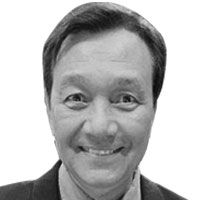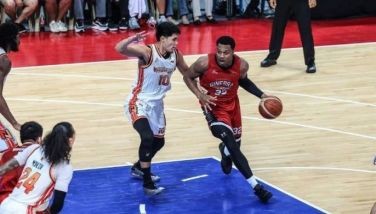Eala lauds US cage diplomacy

April 9, 2005 | 12:00am
Philippine Basketball Association (PBA) commissioner Noli Eala said yesterday the pilot program launched by the Bureau of Educational and Cultural Affairs (ECA) will go a long way in instilling positive values on the youth through sports.
Eala referred to ECA’s approach in sending athletes around the world to reach out to world youth in spreading the gospel of teamwork, free expression and hard work.
A few days ago, Eala met former Georgetown University cager Courtland Freeman at a National Sports Grill reception hosted by the US Embassy in Makati. Freeman and ex-Hoyas teammate Omari Faulker were the first Cultural Envoys for sports deployed by the ECA under the auspices of Culture Connect.
Freeman and Faulkner arrived here last Sunday to assist coach Norman Black in the Jr. PBA clinics and to teach the game in campuses in Manila, Cebu and Davao. Faulkner, however, left a few days later to attend to a personal emergency in the US, leaving Freeman alone to finish the tour.
"I’m very impressed," said Eala. "I found out that the Philippines was the 32nd country Freeman has visited for the ECA in the last eight months. It’s a total commitment. Freeman told me he knew basketball was big here but didn’t realize it was this big."
Speaking at the reception, Freeman acknowledged the PBA for its role in promoting sports. Eala said he was honored that the league was singled out by Freeman.
Others who attended the reception included Talk ‘N’ Text team manager Frankie Lim and coach Joel Banal, Red Bull team manager Tony Chua, Shell coach Leo Austria, Philippine Basketball League commissioner Chino Trinidad, La Salle sports director Danny Jose, Ateneo’s Ricky Palou, and Welcoat team owner Raymund Yu.
Freeman and Faulkner distinguished themselves as responsible athletes when they were Georgetown cagers. Today, they’re living examples of former players making a difference in the global society.
During their overseas travel, the ex-Hoya players are tasked to develop and run basketball clinics, visit schools and discuss sports, educational and cultural issues with young audiences within the 12 to 25 age range.
ECA couldn’t have chosen more inspiring models to demonstrate the positive aspects of American culture.
Freeman battled a spate of back, foot, hand and knee injuries to skipper the Hoyas in three of his five seasons in NCAA Division I. He was selected to the Big East Conference’s All-Academic team and received the Mary Fenlon scholar athlete award in 2002. The next year, he won the Raymond Medley model student athlete award.
Faulkner, 23, was on the university Dean’s List twice and like Freeman, received the Medley and Fenlon awards.
Although they were well-known for their admirable off-court activities, Freeman and Faulkner were–first and foremost–varsity basketball players.
The 6-9, 222-pound Freeman was recruited by Georgetown out of Socastee High in Myrtle Beach, South Carolina, where as a senior, he averaged 17.3 points, 12.2 rebounds and 5.0 blocked shots. Before enrolling at Georgetown, he saw action in the Capital Classic All-Star Game for outstanding prepsters and collected 16 points and seven rebounds.
Writer Michael Bradley described Freeman as an athletic big man who can play two positions–power forward and center. "He’s a good board man (who can) block a couple of shots a game," continued Bradley. "Don’t expect too much offense but he will trigger the break and could even finish a few. He adds another dimension to the frontcourt, thanks to his lean, active body and ability to move well along the baseline."
As a Georgetown rookie in 1999-2000, Freeman averaged 3.1 points, 3.1 rebounds and 14.5 minutes in 34 games. He shot .400 from the field and .467 from the line. Two of his teammates were PBA veterans Jameel Watkins and Wesley Wilson. The Hoyas posted a 19-15 record and lost in the second round of the National Invitation Tournament (NIT) under coach Craig Esherick.
Eala referred to ECA’s approach in sending athletes around the world to reach out to world youth in spreading the gospel of teamwork, free expression and hard work.
A few days ago, Eala met former Georgetown University cager Courtland Freeman at a National Sports Grill reception hosted by the US Embassy in Makati. Freeman and ex-Hoyas teammate Omari Faulker were the first Cultural Envoys for sports deployed by the ECA under the auspices of Culture Connect.
Freeman and Faulkner arrived here last Sunday to assist coach Norman Black in the Jr. PBA clinics and to teach the game in campuses in Manila, Cebu and Davao. Faulkner, however, left a few days later to attend to a personal emergency in the US, leaving Freeman alone to finish the tour.
"I’m very impressed," said Eala. "I found out that the Philippines was the 32nd country Freeman has visited for the ECA in the last eight months. It’s a total commitment. Freeman told me he knew basketball was big here but didn’t realize it was this big."
Speaking at the reception, Freeman acknowledged the PBA for its role in promoting sports. Eala said he was honored that the league was singled out by Freeman.
Others who attended the reception included Talk ‘N’ Text team manager Frankie Lim and coach Joel Banal, Red Bull team manager Tony Chua, Shell coach Leo Austria, Philippine Basketball League commissioner Chino Trinidad, La Salle sports director Danny Jose, Ateneo’s Ricky Palou, and Welcoat team owner Raymund Yu.
Freeman and Faulkner distinguished themselves as responsible athletes when they were Georgetown cagers. Today, they’re living examples of former players making a difference in the global society.
During their overseas travel, the ex-Hoya players are tasked to develop and run basketball clinics, visit schools and discuss sports, educational and cultural issues with young audiences within the 12 to 25 age range.
ECA couldn’t have chosen more inspiring models to demonstrate the positive aspects of American culture.
Freeman battled a spate of back, foot, hand and knee injuries to skipper the Hoyas in three of his five seasons in NCAA Division I. He was selected to the Big East Conference’s All-Academic team and received the Mary Fenlon scholar athlete award in 2002. The next year, he won the Raymond Medley model student athlete award.
Faulkner, 23, was on the university Dean’s List twice and like Freeman, received the Medley and Fenlon awards.
Although they were well-known for their admirable off-court activities, Freeman and Faulkner were–first and foremost–varsity basketball players.
The 6-9, 222-pound Freeman was recruited by Georgetown out of Socastee High in Myrtle Beach, South Carolina, where as a senior, he averaged 17.3 points, 12.2 rebounds and 5.0 blocked shots. Before enrolling at Georgetown, he saw action in the Capital Classic All-Star Game for outstanding prepsters and collected 16 points and seven rebounds.
Writer Michael Bradley described Freeman as an athletic big man who can play two positions–power forward and center. "He’s a good board man (who can) block a couple of shots a game," continued Bradley. "Don’t expect too much offense but he will trigger the break and could even finish a few. He adds another dimension to the frontcourt, thanks to his lean, active body and ability to move well along the baseline."
As a Georgetown rookie in 1999-2000, Freeman averaged 3.1 points, 3.1 rebounds and 14.5 minutes in 34 games. He shot .400 from the field and .467 from the line. Two of his teammates were PBA veterans Jameel Watkins and Wesley Wilson. The Hoyas posted a 19-15 record and lost in the second round of the National Invitation Tournament (NIT) under coach Craig Esherick.
BrandSpace Articles
<
>
- Latest
- Trending
Trending
Latest
Trending
Latest
Recommended
January 10, 2025 - 12:00am




























